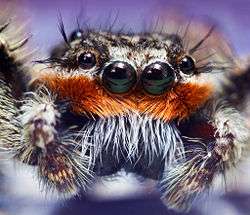Platycryptus undatus
| Platycryptus undatus | |
|---|---|
 | |
| Female Platycryptus undatus | |
| Scientific classification | |
| Kingdom: | Animalia |
| Phylum: | Arthropoda |
| Class: | Arachnida |
| Order: | Araneae |
| Family: | Salticidae |
| Genus: | Platycryptus |
| Species: | P. undatus |
| Binomial name | |
| Platycryptus undatus (de Geer, 1778) | |
| Synonyms | |
|
Aranea undata | |
Platycryptus undatus, also called tan jumping spider, is a species of jumping spider.
Distribution

Platycryptus undatus occurs in North and Central America. The distribution of this species ranges from the Eastern States and adjacent Canada, to Texas and Wisconsin.[1] Females of this species are between 10 and 13 mm in body length, and males range from 8.5 to 9.5 mm. Like some other species of jumping spider, this species appears to exhibit curiosity towards humans who come into its visual field (jumping spiders all have very good vision.) It favors vertical surfaces such as fences, walls, etc. and because of its habits it is easily seen. It does not frantically flee humans and may be gently "herded" onto a hand, where it may make a thorough exploration and even jump from finger to finger. These spiders are not at all inclined to bite, but even though they are rather small they can deliver a defensive bite if they are pinched or squeezed.
Eggs are laid and hatch during the summer, and adults and other stages overwinter in their individual silken shelters. Although the shelters are built separately and keep the spiders out of direct contact with each other, Kaston reports that as many as fifty of them may crowd their shelters for hibernation together so tightly that they form a continuous blanket under the loose bark of a standing tree.[2]
Physical characteristics
The bodies of these spiders are rather compressed in the vertical direction, which allows them to hide themselves under the loosened bark of trees and in other tight places. They have a prominent pattern on their abdomens which may make them more difficult to distinguish on mottled surfaces.
References
- Platnick, Norman I. (2008): The world spider catalog, version 8.5. American Museum of Natural History.
External links
| Wikimedia Commons has media related to Platycryptus undatus. |
- Picture of P. undatus (free for noncommercial use)
- Good information on spiders' lifestyles from the University of Kansas.
- Lucian K. Ross: A jumping spider feeding on an earthworm. Peckhamia, 71, 1, S. 1-2, September 2008 PDF